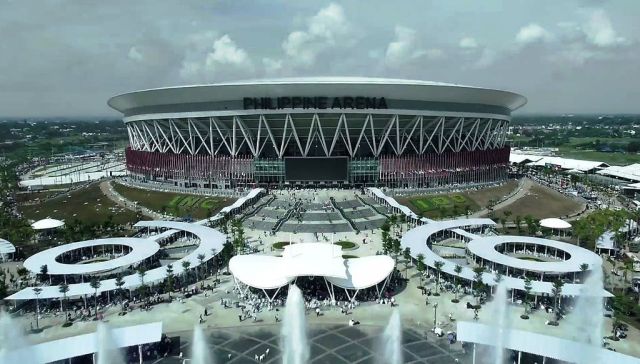Entertainment has bought a lot of people together to share and experience different activities and to witness events worth remembering. Entertainment keeps a person engaged and interested and it eases boredom. Entertainment can range from theatrical performances to concerts to sport events. With the rise of the new media, people can now be entertained online with the help of the Internet. But nobody could deny the pleasure and the happiness people get when allowed to witness an event live and personal. The pandemic, however, isolated everyone and watching idols and stars perform and play cannot be possible yet. Even so, it is possible to look at the world’s largest arena where basketball, boxing events and concerts takes place and plan for the next live event that you’ll watch.
The world’s largest domed indoor arena
The Philippine Arena, the world’s largest indoor arena, is located at a 50-hectare complex called Ciudad de Victoria (City of Victory) in Santa Maria, Bulacan in the Philippines. It is owned by an independent non-trinitarian Philippine-born Christian church, Iglesia ni Cristo (Church of Christ).
In the year 2014, the Guinness World Records recognized the arena as the world’s largest multipurpose indoor theater. By then, the arena has already hosted multiple events for big crowds. The arena is capable of holding different types of gatherings and events including major church gatherings to sports venue to concert venue.
In fact, the arena was first conceptualize because of the need of the Church of Christ of a larger venue to host religious ceremonies for their church because of it’s growing number of members. While the arena’s first concept was to be used for religious activities, it can be used to cater other activities because it has been equipped so. The Philippine Arena is measured 243 meters long and 193 meters wide with an expansive floor area of 99,000 square meters. The arena can accommodate 50,000 people inside the arena and an addition 50,000 in the “live site” outside the arena.
The Philippine Arena is shaped like. a tight and compact saddle that is high in the centre and drops at the side, designed like a bowl. Video boards are also placed in front to provide additional viewing. The Philippine Arena is inspired by the Filipino Nipa-Hut and the Narra tree. It symbolizes the endurance, the strength and the unconquerable spirit of the people.
Situated at the world’s most densely populated city
The arena stays home at the world’s most densely populated city, Manila, with 46,178 people per square kilometer. The arena was designed to gather 50,000 people while avoiding the feeling of emptiness when the arena is hosting smaller events and while creating an intimate atmosphere. The arena’s entrances send people immediately to clear pathways enabling a quicker and safer entrances and exits. To keep the audiences cool, with Manila’s humid and tropical climate, the arena is fully air-conditoned and well-ventilated.
Designed by the world’s famous architect, engineer and construction firms
The Church of Christ commisioned Populous, a Kansas City-based global mega-architecture firm, to design an arena that can hold 50,000 people for different events and major gatherings. Populous worked with Buro Happold, a firm of engineers, consultants and advisers and South Korea’s Hanwha Engineering Construction Corporation to design and build the arena.
Populous’ projects includes the Coca-Cola Arena in Dubai, Pepsi Center in Denver, The O2 Arena in London, Citi Field in New York, Emirates Stadium in London and many more. Buro Happold’s projects includes the Grove Towers, Louvre Abu Dhabi, London 2012 Olympic Stadium, SkyWalk in King Power MahaNakhon, The World Towers in Mumbai and many more. Hanwha Engineering Construction Corporation has constructed chemical plants in the Middle East and North Africa. In South Korea, the firm has constructed 70,000 households at 95 sites.
One of the world’s fastest construction timeline
With 2,500 construction workers and 40 engineers, who worked on different shifts, the arena was completed in a span of two years and nine months setting a record as one of the fastest construction of a megastructure.
One of the world’s top five earthquake-resistant megastructures
Having been situated at the Pacific “Ring of Fire”, Philippines is prone to tectonic movements and volcanic activities which makes earthquakes occur frequently, some of which are highly destructive. The Philippine Arena is situated 24 kilometers away from the West Valley Fault, an active fault that crosses the city of Manila and nearby provinces, which makes it risky for destruction if the fault moves. A reason why the arena needs to be designed in a way that it can withstand strong seismic vibrations. Powerful earthquakes with deadly magnitudes can cause volcanoes to ignite, summon tsunamis and bring tropical typhoons to the country that can cause intense flooding. That is the biggest challenge of the architects and engineers who designed the Philippine Arena.
According to Buro Happold, one of the engineering firm that designed the Philippine Arena, their solution to the situation aforementioned “was to design a foundation and base that is independent from the rest of the arena structure, isolating the building at ground-level to reduce accelaration of forces.” The foundation that the arena is supported is a mechanical device called lead rubber bearings that allows the base of the arena to move with the raging quake tremors while the structure will stay stable.
Due to the pandemic, gatherings are still not allowed. Instead, reminisce on the memories you had with people you love. Look back at the days when you watched a concert at an arena like the Philippine Arena or the moment you watched your sports idol play. Those memories are special so hold them close to your heart. This pandemic will be over soon and by that time you can hold celebrations and gatherings. That place might not be as big as the Philippine Arena but the entertainment you enjoyed and the fun things you did is what matters the most.
By Alenah Paulane P. Ligan, Tagbilaran City, Bohol, Philippines











